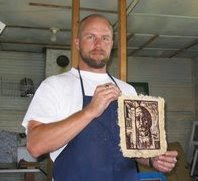I enjoy working with a variety of media. I think most of the work in this blog does a pretty good job of showing that. That interest is more obvious in my paintings as they are almost all constructed using a variety of media. I've come to find that one advantage of an art education major is the variety of classes that are aplicable to the course of study. I could take everything from drawing and painting classes to basket weaving and jewelry design and it would all help me acquire units for graduation. This interest in multiple media compliments my appropriation of different sources for information and meaning.
In a discussion with one of my students about her artwork she mentioned the fact that she liked working with a digital drawing tablet. I've seen them in Fry's and often wondered how they worked for making artwork. I figured in order to continually improve my ability as a teacher I must be prepared to discuss work in a greater variety of media so I bought one.
The one I bought was relatively inexpensive but effective. It works well with Photoshop but I couldn't get the pressure settings to work in GIMP though they are supposed to. To make an exceptionally long story short it is a lot of fun to use. I am able to scan things in on a whim, reproduce images endlessly, and apply the human contact present in conventional media through the drawing tablet (that contact is at least as close to the final image as possible given the media- not quite like smudging with your finger tip, but you get the point).
These are a couple of samples of the work- just sketches from a couple of evenings in the studio.
In a discussion with one of my students about her artwork she mentioned the fact that she liked working with a digital drawing tablet. I've seen them in Fry's and often wondered how they worked for making artwork. I figured in order to continually improve my ability as a teacher I must be prepared to discuss work in a greater variety of media so I bought one.
The one I bought was relatively inexpensive but effective. It works well with Photoshop but I couldn't get the pressure settings to work in GIMP though they are supposed to. To make an exceptionally long story short it is a lot of fun to use. I am able to scan things in on a whim, reproduce images endlessly, and apply the human contact present in conventional media through the drawing tablet (that contact is at least as close to the final image as possible given the media- not quite like smudging with your finger tip, but you get the point).
These are a couple of samples of the work- just sketches from a couple of evenings in the studio.


